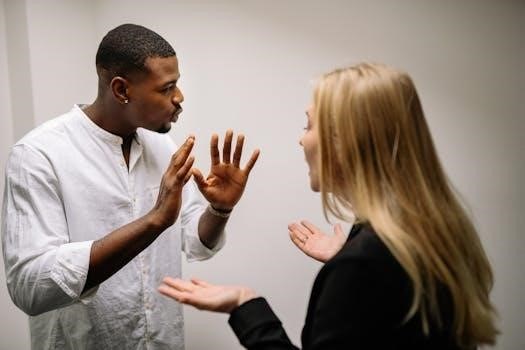Social Problem Solving Scenarios⁚ A Comprehensive Guide
This guide explores social problem-solving scenarios and their importance. It offers practical examples, resources, and strategies for educators and parents. Discover how these scenarios foster crucial skills. These skills involve empathy, conflict resolution, and emotional intelligence. Learn to adapt situations for diverse learners, including students with autism.
Social problem-solving scenarios are invaluable tools designed to cultivate essential life skills, particularly among younger individuals. These scenarios present simulated real-world situations, prompting individuals to analyze, strategize, and develop effective solutions. By engaging with such scenarios, participants learn to navigate complex social dynamics, understand diverse perspectives, and make responsible decisions.

These scenarios serve as a safe space to practice critical thinking and creative problem-solving, fostering resilience and adaptability. They aid in developing crucial skills, including empathy, perspective-taking, and conflict resolution, which are foundational for positive social interactions. Furthermore, visual aids and role-playing techniques can enhance the learning experience, making it more engaging and impactful.
The application of these scenarios extends across various educational settings and age groups, catering to both elementary and secondary students. Adapting scenarios for students with autism spectrum disorder ensures inclusivity and personalized learning. By mastering social problem-solving, individuals become better equipped to handle real-life challenges, promoting positive behaviors and contributing to a harmonious society.
Benefits of Using Social Problem Solving Scenarios
Social problem-solving scenarios provide numerous benefits, fostering crucial skills for navigating real-life situations. These scenarios enhance empathy by encouraging individuals to consider others’ perspectives and feelings. By understanding different viewpoints, participants develop stronger interpersonal relationships and communication skills. Scenarios also improve conflict resolution abilities, teaching effective strategies for managing disagreements and finding mutually agreeable solutions.
Furthermore, these scenarios boost critical thinking by prompting individuals to analyze situations, identify problems, and evaluate potential solutions. This process cultivates decision-making skills, empowering individuals to make informed choices in various contexts. Social problem-solving scenarios also promote emotional intelligence, helping individuals recognize and manage their own emotions while understanding those of others.
Additionally, these scenarios foster creativity by encouraging participants to generate innovative solutions to complex problems. This creative thinking can be applied to a wide range of situations, both personal and professional. Ultimately, using social problem-solving scenarios equips individuals with the tools they need to thrive in diverse social environments, fostering positive interactions and successful outcomes. These skills contribute to overall well-being and success in life.

Key Skills Developed Through Social Problem Solving
Social problem-solving cultivates a range of essential skills crucial for personal and social development. Empathy emerges as a cornerstone, enabling individuals to understand and share the feelings of others, fostering compassion and connection. Perspective-taking, closely linked to empathy, allows one to see situations from different viewpoints, promoting tolerance and reducing misunderstandings. Effective communication skills blossom as individuals learn to articulate their thoughts and listen attentively to others, enhancing collaboration and resolving conflicts constructively.
Conflict resolution skills are honed through analyzing problems, generating solutions, and negotiating compromises, leading to peaceful and mutually beneficial outcomes. Critical thinking sharpens as individuals evaluate information, identify biases, and make informed decisions, improving judgment and problem analysis. Emotional regulation strengthens as individuals learn to manage their emotions in challenging situations, promoting resilience and self-control. Decision-making skills develop as individuals weigh options, assess risks, and choose the most appropriate course of action, leading to effective solutions.
Creativity flourishes as individuals generate novel and innovative solutions to complex problems, fostering adaptability and resourcefulness. These skills collectively empower individuals to navigate social complexities with confidence, build strong relationships, and contribute positively to their communities, ensuring overall well-being and success. Social problem-solving is vital.
Social Problem Solving Scenarios for Elementary Students
Social problem-solving scenarios are invaluable tools for elementary students, fostering essential life skills through engaging and relatable situations. These scenarios help children develop empathy by encouraging them to understand and share the feelings of others. Perspective-taking is cultivated as students learn to see situations from different viewpoints, promoting tolerance and reducing conflicts. Communication skills are enhanced as they articulate their thoughts and listen attentively, fostering collaboration and understanding.
Conflict resolution is taught through analyzing problems, generating solutions, and negotiating compromises, leading to peaceful resolutions. Scenarios like “The Lost Toy,” “The Broken Pencil,” and “The Group Project” provide practical examples of common challenges faced by elementary students. These activities promote emotional intelligence, helping children manage their emotions and build positive relationships. Visual aids, such as pictures and diagrams, can be used to enhance understanding and engagement. Role-playing activities allow students to act out scenarios, reinforcing their learning and building confidence.
By engaging in social problem-solving, elementary students develop crucial skills that aid in academic, personal, and social growth. These scenarios equip them with the tools to navigate social complexities, build strong relationships, and contribute positively to their classrooms and communities. This fosters a supportive and inclusive learning environment.
Social Problem Solving Scenarios for Middle and High School Students
For middle and high school students, social problem-solving scenarios become more complex, addressing the nuanced social dynamics and challenges prevalent in adolescence. These scenarios help students navigate peer pressure, relationship conflicts, and ethical dilemmas with greater maturity. They foster critical thinking skills by requiring students to analyze complex situations, evaluate potential consequences, and make informed decisions. Empathy is further developed through scenarios that explore diverse perspectives and promote understanding of others’ experiences.
Effective communication skills are emphasized, teaching students how to express their needs assertively while respecting the opinions of others. Scenarios related to social media, bullying, and academic integrity provide relevant and engaging contexts for discussion. Conflict resolution strategies are refined, teaching students how to mediate disputes, negotiate compromises, and seek mutually beneficial solutions. Activities like role-playing and group discussions encourage students to practice these skills in a safe and supportive environment.

By engaging in social problem-solving, middle and high school students develop crucial skills for navigating the complexities of adolescence and preparing for adulthood. These scenarios equip them with the tools to build healthy relationships, make ethical decisions, and contribute positively to their communities. This fosters a sense of responsibility and empowers them to become active, engaged citizens. They learn to effectively address personal and social challenges, promoting resilience and well-being.
Real-Life Social Problem Solving Scenarios Examples
Real-life social problem-solving scenarios provide practical opportunities to apply critical thinking and empathy. Imagine a situation where a student notices a classmate being excluded during lunch. A helpful solution involves initiating a conversation and inviting them to join the group, fostering inclusion. Consider a scenario where friends disagree on a movie choice for movie night. A collaborative approach is to discuss each preference, negotiate, and perhaps alternate choices each time.
Another example involves navigating a misunderstanding with a friend on social media. A constructive response involves directly communicating your feelings and seeking clarification. Ethical dilemmas also arise in academic settings, such as witnessing a student cheating on a test. A responsible approach involves reporting the incident to a teacher or trusted adult, upholding academic integrity. Scenarios involving community interactions include observing someone struggling with heavy bags.
Offering assistance exemplifies kindness and social responsibility. These examples illustrate how social problem-solving skills can be applied in various contexts. This promotes positive interactions and helps build stronger communities. By encouraging students to consider these scenarios, we empower them to become proactive problem-solvers. This helps create a more supportive and inclusive environment. It also helps them effectively address challenges and build stronger relationships. These skills prepare them to navigate real-world complexities.
Using Visual Aids in Social Problem Solving Scenarios
Visual aids enhance social problem-solving scenarios by providing concrete representations of abstract concepts. Picture cards depicting emotions, such as happiness, sadness, and anger, help students identify and understand feelings. Social stories, which use visuals and simple text, illustrate social situations and appropriate responses. For example, a social story about sharing toys can show children taking turns and playing together cooperatively.
Comic strip conversations, where dialogues and actions are visually represented, facilitate understanding of social interactions. Visual schedules outline steps for resolving conflicts, promoting structured problem-solving. Charts displaying problem-solving steps, like identifying the problem and brainstorming solutions, offer a clear framework. Real photos of social situations provide realistic contexts for analysis and discussion.
Interactive whiteboards enable collaborative problem-solving, allowing students to manipulate visual elements and generate solutions together. Videos demonstrating positive social behaviors serve as models for emulation. Mind maps visually organize potential solutions and their consequences, fostering critical thinking. Utilizing visual supports caters to diverse learning styles. This makes social problem-solving more accessible and engaging. By incorporating these aids, educators empower students to navigate complex social situations effectively. This promotes greater understanding and skill development. It also fosters a more inclusive and supportive learning environment.
Incorporating Role-Playing in Social Problem Solving Activities
Role-playing brings social problem-solving scenarios to life, allowing students to actively practice skills in a safe environment. Assign roles based on the scenario, encouraging students to embody characters and their perspectives. This promotes empathy and understanding of diverse viewpoints. Provide clear guidelines and objectives for each role-play, focusing on specific problem-solving steps.
Encourage students to improvise within the scenario, fostering creativity and adaptability. Debrief after each role-play, discussing what went well and areas for improvement. Ask students to reflect on their feelings and the impact of their actions. Use props and costumes to enhance engagement and realism, making the activity more immersive.
Model effective communication and problem-solving techniques, demonstrating positive behaviors. Create a supportive atmosphere where students feel comfortable taking risks and making mistakes. Adapt scenarios to reflect real-life situations relevant to students’ experiences. Incorporate peer feedback, allowing students to learn from each other’s insights and perspectives. Encourage students to generate their own scenarios, fostering ownership and creativity. Role-playing helps students develop critical thinking, communication, and conflict-resolution skills. This prepares them to navigate social challenges effectively. It also promotes confidence and self-awareness. By actively engaging in these scenarios, students internalize strategies. These strategies lead to positive social interactions.
Addressing Emotional Intelligence in Social Problem Solving
Emotional intelligence is crucial in navigating social problem-solving scenarios effectively. It involves understanding and managing one’s own emotions. It also involves recognizing and responding to the emotions of others. Begin by helping students identify and label their feelings in different situations. Encourage them to express their emotions appropriately, using “I” statements to communicate needs and boundaries. Teach active listening skills, emphasizing empathy and perspective-taking.
Model emotional regulation techniques, such as deep breathing and mindfulness. These will help students manage stress and impulsivity. Incorporate scenarios that require students to consider the emotional impact of their actions on others. Discuss how different emotions can influence decision-making and problem-solving strategies. Encourage students to develop empathy by imagining themselves in others’ situations.
Facilitate discussions about emotional responses and healthy coping mechanisms. Provide opportunities for students to practice self-awareness and self-regulation. Help them recognize triggers that lead to emotional outbursts and develop strategies for managing them. Create a supportive classroom environment where students feel safe expressing their emotions. Encourage students to validate each other’s feelings, even if they don’t agree with their actions. By developing emotional intelligence, students will be better equipped to navigate social challenges. They will also build stronger relationships and make responsible decisions. These skills are essential for success in school, work, and life.
Adapting Scenarios for Students with Autism
Adapting social problem-solving scenarios is critical for students with autism. These students often process social information differently. Start by using clear, concise language and avoiding abstract concepts. Break down complex scenarios into smaller, manageable steps. Visual supports, such as picture cards or social stories, can enhance understanding. Provide explicit instructions and structured routines to reduce anxiety.
Focus on concrete, observable behaviors rather than inferred emotions. Teach specific social skills, such as initiating conversations or taking turns. Use role-playing to practice these skills in a safe, controlled environment. Offer positive reinforcement and immediate feedback to encourage desired behaviors. Consider the student’s sensory sensitivities and modify the environment accordingly. Minimize distractions and provide a quiet space for processing information.
Incorporate the student’s interests into the scenarios to increase engagement. Allow extra time for processing and responding to questions. Be patient and understanding, recognizing that progress may be gradual. Collaborate with parents, therapists, and special educators to develop individualized strategies. Use real-life scenarios that are relevant to the student’s experiences; Teach strategies for self-advocacy, empowering students to communicate their needs effectively. Remember to celebrate small victories and focus on building confidence; Adapt scenarios to match the student’s developmental level and cognitive abilities. By tailoring the approach, we can help students with autism develop essential social problem-solving skills.
Free Resources for Social Problem Solving Scenarios (PDFs)

Numerous free resources are available online for social problem-solving scenarios in PDF format. These resources offer a variety of scenarios suitable for different age groups and skill levels. Teachers Pay Teachers provides a marketplace with free and paid resources. Many websites offer downloadable PDFs with social situations and corresponding images. These resources often include open-ended questions to stimulate critical thinking.
Look for resources that address specific social skills, such as empathy, perspective-taking, and conflict resolution. Some PDFs provide visual aids to support understanding. Others offer blank templates for creating customized scenarios. Smart Speech Therapy offers a selection of scenarios specifically geared for speech therapy social skills training.
Consider exploring resources that include real-life problems clients navigate at school and home. These scenarios often present problems and ask the client to discuss possible solutions. Utilize resources offering social stories, which provide a narrative context for understanding social situations. The Reading Mama offers free social problem-solving posters for classroom use. Ensure the resources align with the student’s developmental level and learning needs. Evaluate the quality and relevance of the scenarios before use. These free PDFs can be invaluable tools for educators and parents. They promote positive social behaviors and foster emotional intelligence. Be sure to check for resources that can be used in teletherapy/virtual or in-person settings.
Creating Custom Social Problem Solving Scenarios
Crafting custom social problem-solving scenarios allows educators and parents to tailor learning experiences. Start by identifying specific social skills a student needs to develop. Consider real-life situations the student encounters regularly. Observe the student’s interactions and note any recurring challenges.
Design scenarios that reflect these challenges, ensuring relevance and engagement; Incorporate the student’s interests and hobbies to increase motivation. Use simple, clear language appropriate for the student’s comprehension level. Frame the scenario with a specific problem that needs resolution. Outline the context, including the setting, people involved, and the events leading to the problem.
Develop open-ended questions that encourage critical thinking and problem-solving. Include questions prompting the student to identify emotions, perspectives, and potential solutions. Ensure scenarios promote empathy and perspective-taking. Consider adding visual aids to support understanding, especially for visual learners. Role-playing can also enhance engagement and provide practical application. Adapt the complexity of the scenarios to match the student’s progress. Regularly review and revise scenarios based on the student’s feedback and outcomes. Creating custom scenarios ensures targeted and effective social skills development. Remember to focus on positive solutions and reinforce appropriate behaviors. These scenarios are most effective when they are directly relevant to the student’s life. Custom scenarios can be powerful tools for fostering social competence and confidence.
